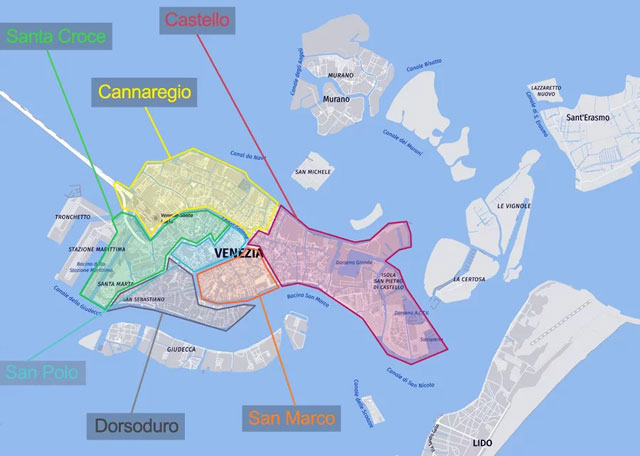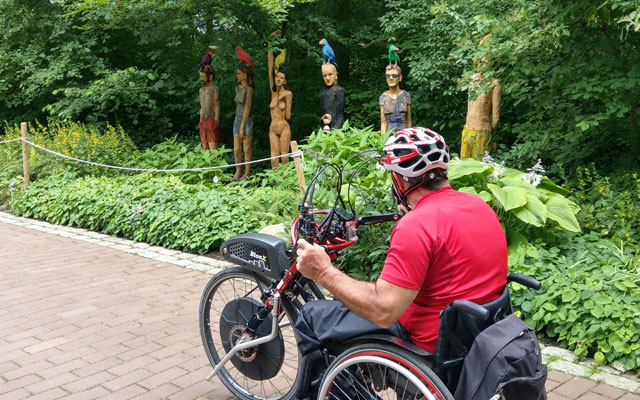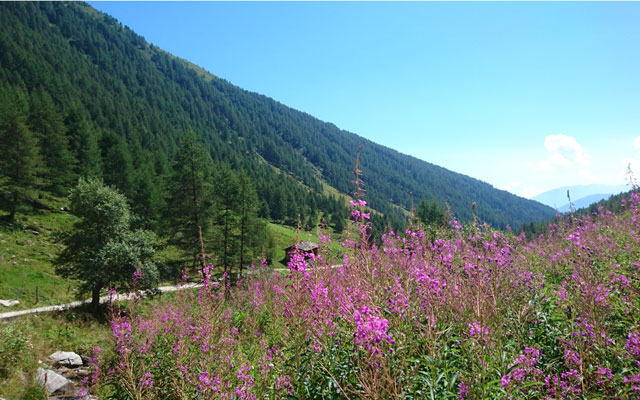Our Venice
On the way in the Sestiere Dorsoduro
In this article we deal with the islands of Dorsoduro, a district (Sestiere) in the southern part of the old town.
In this part, we'll look at
- Fondamenta Zattere
- Campo Santa Margherita
and the surrounding islands. Of course, Dorsoduro has a lot more to offer - you'll find out more about it next time 🙂

By loading the map, you accept Google's privacy policy.
Learn more

The islands of Venice
Dorsoduro
The Sestiere Dorsoduro has approx. 15,500 inhabitantsmost of which, however, are on the Giudecca and Sacca Fisola islands live. Both are slightly larger islands offshore from the other islands of Dorsoduro in the lagoon. The small island Sacca San Biagio west of Sacca Fisola is the only uninhabited island of the sestiere.
The Sestiere of Dorsoduro consists (without Guidecca and Sacca Fisola) of 17 individual islands and includes a Area of 92 hectares.
The Name Dorsoduro derives - similar to Cannaregio - from the nature before the settlement of the islands. Dorso duro translated means hard back and is meant to indicate that the islands have a solid, partly rocky subsoil.
Dorsoduro is characterized by its wealth of magnificent sacred buildings from. The earlier architects, builders and master builders were able to use two long banks (on the Grand Canal and the Zattere) in the old town and also on Giudecca and the island of San Giorgio to realise their visions.
One of the most beautiful buildings of the quarter is the Palazzo Dario on the Grand Canal (for wheelchair users, unfortunately, only visible from the vaporetto). The Palazzo is considered one of the most characteristic palaces of the city.
Dorsoduro is also home to some important art institutions such as a collection of Peggy Guggenheimthe Emilio and Annabianca Vedova Foundation and the Punta della Dogana Art Museum.
accessibility
The administration of Venice provides each year 4 temporary ramps in Dorsoduro up and that during school hoursperiod from September to June. During this time you can visit the islands by wheelchair best to visit. So, in July and August, visiting Dorsoduro is a little more difficult, because instead of crossing the bridges equipped with ramps, you can only get from one island to the next by vaporetto.
In the eastern area of Dorsoduro, the ramps are installed at the following bridges: Ponte della salute, Ponte della Calcina, Ponte degli Incurabili and Ponte Longo. In this way, they guarantee accessibility to the most important facilities for both the citizens of Venice and tourists.
La Fondamenta delle Zattere
Dorsoduro
The Fondamenta delle Zattere, also known simply as the Zattere, is a long waterfront street that forms the southern boundary of Venice's old town. The Fondamenta begins near the Stazione Marittima San Basilio and runs for just over a kilometre to the Punta delle Dogana, where the Giudecca Canal flows into the San Marco basin.
Since the Fondamenta is located on the south side of the island of Dursoduro, it is often very sunny here and therefore the promenade is a popular destination for spring and summer walks. Therefore, many small shops such as bars, ice cream parlors and restaurants have also settled along the Zattere.
Approach Accademia
Tour Accademia - Zattere - Salute
As explained in our first post, Venice is easy to get to.
The usual places to go are Piazzale Roma and Santa Lucia train station. From here you can take the vaporetti (water buses) towards the different parts of the city.
The islands of Dorsoduro can be reached via various stops on lines 1 and 2.
To do the tour mentioned below, it is best to drive from Piazzale Roma by which Vaporetto line 1 or 2 along the Grand Canal to the Accademia stop.
From Tronchetto either with the People Mover to Piazzale Roma and from there further as described above or with the Vaporetto line 2 directly to the Accademia stop.
Tour: Accademina - Zattere - Salute
Sightseeing Tip 1
On this tour we visit several islands of Dorsoduro and make a tour of Zattere - Accademia - Salute.
At the Accademia stop is where our tour begins.
Gallerie dell'Accademia
Right next to the stop is the Gallerie dell'Accademia, a Museum complexwho has the church Santa Maria della Carità, the associated monastery and the rooms of the school of the same name Scuola Grande and dates back to the 12th century. The recently restored museum houses a large collection of paintings from the 14th to the 18th century.
Galleria di Palazzo Cini
From the exit on the left side of the Gallerie dell'Accademia in the street Rio Terrà Foscarini we first take the road Calle Nuova Sant'Agnese and then the Piscina del Fornerto go to the Galleria di Palazzo Cini which was set up in Palazzo Foscari, built in 1565 and acquired by the collector Vittorio Cini in 1919.
The collection shown here consists of paintings, sculptures and art objects from the period between the 13th and 16th centuries.
Palazzo Cini is barrier-free and has a lift. To make sure it is in operation, it is advisable to ask before visiting the gallery. (Telephone: +39 041 2710217/ +39 041 2710229).
Fondamenta Zattere
After visiting Palazzo Cini, we return to Rio Terrà Foscarini street, turn left and reach Riva delle Zattere on the Giudecca Canal.
On the right hand side we pass the classicistic facade of the Church of S. Maria del Rosario ai Gesuati, which was built as an extension of a small church and which still stands next to it. The side entrance to the church has 4 steps of about 16 cm.
We now turn left on the southern bank of Dorsoduro and walk along the Fondamenta delle Zattere along until we reach the bridge Ponte della Calcina and reach the boarding house of the same name, where the English man of letters John Ruskin stayed for a long time.
Palazzo Venier dei Leoni
After we have crossed the bridge, we immediately turn left into the Fondamenta de Ca' Bragadin (directly at the bridge, possibly, go back a bit) and then a bit later turn right into the Calle de la Chiesa (now you can also see Palazzo Cini from the other side of the canal).Calle de la Chiesa turns into Fondamenta Venier dei Leoni and on this way we get to the Palazzo Venier dei Leoniin which, since 1980, the collection of Peggy Guggenheim one of the most important collections of contemporary art of the 20th century. The Palazzo Venier dei Leoni is a uncompleted buildingalso known under the name "palazzo non finito" (German: unfinished palace), behind which is a garden where the Venier family is said to have kept a lion (leoni: lions). The Nasher Sculpture Gardenthe exhibition site of the Guggenheim collection and other works of art, are accessible thanks to various elevators. accessible. Then we go back the same way to the Ponte della Calcina.
Accademia di Belle Arti di Venezia
From the Fondamenta Zattere you have a beautiful view over the Giudecca canal and from the bridge on the other side of the canal you can see the famous churches Palladio delle Zitelle and Redentore. From here you can walk along the Zattere, across the Ponte degli Incurabili and the Ponte Ca' Balà by Ex Ospedale degli Incurabili continue. The Ospedale (German roughly: hospital of the incurable) is the current seat of the Accademia di Belle Arti di Veneziaone of the most renowned College of Art Italy. The school is accessible via a small lift.
Continuing straight on you reach Casa Cicogna, designed by the architect Iganzio Gardella, and the Church Chiesa dello Spirito Santo and the associated monastery, which is famous for its Lombard façade dating from 1483.
Emilio Annabianca Vedova Foundation
Further along the Fondamenta you will find the Emilio Annabianca Vedova Foundationwhose showroom is located in the building Magazzino del Sale designed by Renzo Piano. At the entrance there are three steps of about 17 cm, which can be climbed thanks to a small lifting platform. Not far away, still on the Fondamenta Zattere, are the Saloni, at number 50, another exhibition space of the Foundation, accessible directly from the side street.
From the Fondamenta Zattere we turn now left into the Rio Terrà Saloni and follow it to the Rio Terrà Catecumeni. We cross this first and follow Calle di Mezzo until we reach Calle del Bastion. Here we turn right and find ourselves directly in front of the Chiesa San Gregorio from the Carolingian Renaissance. The adjacent monastery is also used today as an art exhibition space in connection with the La Biennale, an internationally renowned exhibition.
Basilica della Madonna della Salute,
We go back to the Rio Terrà Catecumeni, walk along it on the left and then we find ourselves at the Ponte della Salute. Over the bridge we reach the majestic Basilica della Madonna della Salute, a masterpiece by Baldassare Longhena, built between 1631 and 1687 as a memorial to the liberation from the plague. The church is not accessible because of the steps - with one exception: The feast of the Madonna della Salute takes place on 21 November and on this occasion a ramp installed, so that all may enter the basilica.
From the Basilica you can see the Punta della Dogana a 17th-century building that once housed the Venetian Republic's shipping customs office and now houses the Contemporary Art Exhibition Centre, thanks to a project by Japanese architect Tadao Ando. The latter, together with the Palazzo Grassi the museum complex of the François Pinault Foundation. The exhibition rooms are all accessible via lifts inside the building. From the end of the Punta della Dogana one has a magnificent view of the San Marco basin and the island of San Giorgio.
Continue
From here you can now start with the Vaporetto line 1 from the station Salute proceed to the next desired station.
Who subsequently Tour Santa Margherita would like to make, goes the way up to the church S. Maria del Rosario ai Gesuatiwhere we entered the Fondamenta Zattere for the first time. From the Ponte Longo we then continue to Campo Santa Margherita.
You can also reach the Zattere stop (right at Ponte Longo) with line 2, but for that you have to take line 1 stop Salute to another stop where you can change to line 2. The way on foot is probably less time consuming.
Click the button below to download the content of www.komoot.de.
Campo Santa Margherita
Dorsoduro
Approach San Basilio
Starting point of the tour to Campo Santa Margherita
As explained in our first post, Venice is easy to get to.
The usual places to go are Piazzale Roma and Santa Lucia train station. From here you can take the vaporetti (water buses) towards the different parts of the city.
For the tour listed here we start at the San Basilio stop. This is located directly at the beginning of the Fondamenta Zattere and from here you can easily reach the Ponte Longo and thus achieve the two Tours Zattere and Santa Margherita interconnect.
You can get to the San Basilio stop from the Piazzale Roma by which Vaporetto 5.1. counterclockwise.
From Tronchetto from you can Vaporetto line 2 in the direction of the Canale delle Giudecca and at the San Basilio stop Get out.
Tour: Campo Santa Margherita
Sightseeing Tip 2
We start the tour at the Vaporetto stop San Basilio right towards Ponte Longo. Just before the bridge are the offices of the University Ca' Foscari and the Biblioteca di Servizio Didattico. Here it is perhaps good to know that these are a accessible WC which can be reached by elevators and ramps.
On the way back in the direction of the bus stop you can see the V-A-C Foundation which is also accessible via a ramp and interior elevators.
Back at the bus stop we turn right into the street Vento Street, walk a bit along the Rio San Sebastiano the Fondamenta de S. Basegio along and can then, after the second bridge, on the other side of the canal the Church of San Sebastiano marvel at.
Palazzo Zenobio
We go along the street Fondamenta de S. Basegio until the end and have to turn right here because of a canal. Fondamenta Soccorso turn off. Here is the Palazzo Zenobio, a imposing building from the 17th century and in which the veduta painter Luca Carlevaris lived. The building, which is currently used as a college, also includes a beautiful gardenwhich can be visited by telephone or e-mail (+39 041 5228770, info@collegioarmeno.it).
Church Chiesa dei Carmini & Scuola Grande dei Carmini
At the end of the Fondamenta Soccorso is the church dedicated to S. Maria del Carmelo. Chiesa dei Carmini. Inside the church you can see the original Gothic architecture from the 14th century including the 3 naves separated by columns. In the church you can move barrier-free and so also the Altarpiece of Cima da Conegliano and admire a painting by Palma il Giovane. The church has two entrances. The main entrance, facing the Campo dei Carmini, has a 14 cm high step and the Side entrance a 5 cm high step.
Next to the church is one of the six Scuole Grandi of Venice: the Scuola Grande dei Carmini from the late 17th century, which goes over two floors connected by an imposing staircase. The staircase has two landings and at the end of the second landing is the hall Sala Capitolarewhere the famous paintings by Giambattista Tiepolo are displayed. Unfortunately, both the entrance, which has 3 steps with a height of 15 cm, and the stairs do not have aids for people with reduced mobility.
Campo Santa Margherita
Adjacent is the Campo Santa Margherita, one of the most characteristic and lively of the city, also because of the presence of many students studying in the nearby universities. On the Campo there are many Bars and pizzeriaswhere you can also sit and eat comfortably outdoors. In the centre of the square stands a single building, built in 1725, which served as the seat of the Scuola dei Varoteri. Today the building houses the local Police Department.
Not far away, at the end of Campo Margherita in Calle de la Chiesa, there is also the Auditorium Santa Margherita of Ca' Foscari University, where meetings, congresses and cultural events are held. The main entrance has two steps, while access via the side entrance is less difficult, as there is only a slight difference in height.
Campiello degli Squellini
If you do not cross the Campo, but pass it on the right and enter the street Rio Terà Canalthen left and then right again, you first reach the road Scaleter Street. At the end of the road turn right into Calle de le Boteghe and then left again into Calle Cappeller, you reach the small square Campiello degli Squellini. The name derives from the majolica bowls produced by a factory that was located in this Campiello. A few steps away is also the seat of the University Ca' Foscari.
Palazzo Ca' Rezzonico
From Camielle degli Squellini it is possible to reach, without barriers, the Palazzo Ca' Rezzonico which is now the seat of the Museo del Settecento Veneziano (Museum of 18th Century Venice). The palace, the work of Baldassarre Longhena and Giorgio Massari, houses important paintings by Tiepolo, Rosalba Carriera, Longhi, Guardi and Canaletto, which are exhibited together with precious furniture and furnishings of the period.
The Palazzo can be reached by walking back the same way along Calle Cappeller until just before Calle de le Boteghe. Just before, at Calle del Fabro, an inconspicuous entrance turns off to the left - Calle Pedrocchi. At its end we meet the Fondamenta Rezzonico. Here we turn left and come to the entrance of the Palazzo.
On the ground floor, around the entrance hall, there is the Info Point, the ticket office, the cloakroom, a bookshop and the cafeteria. There are also barrier-free toilets and an elevator to all exhibition rooms.
Continue
Unfortunately, to get back to the starting point, the San Basilio stop, you have to walk back the entire route.
If you would like to use the Tour San Marta which continues in a westerly direction, then you can go directly to the Vaporetto stop San Basilio the Ponte Molin (this is equipped with a metal ramp from September to June).
Otherwise there is the possibility to continue from the stops San Basilio and Zattere to the next desired place.
Click the button below to download the content of www.komoot.de.
Next time
In the next post, you'll get tips from us on the
Santa Marta & Rialto Mercato
So check back or better yet - subscribe to Wheelchair Tours on the social media channels!



